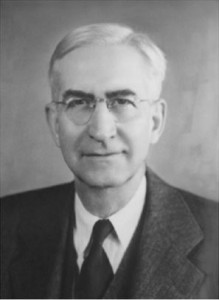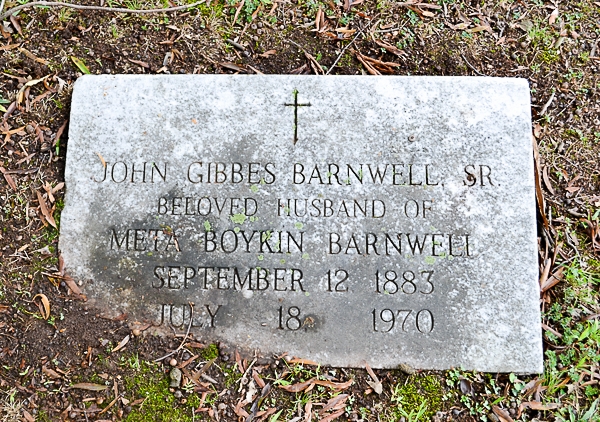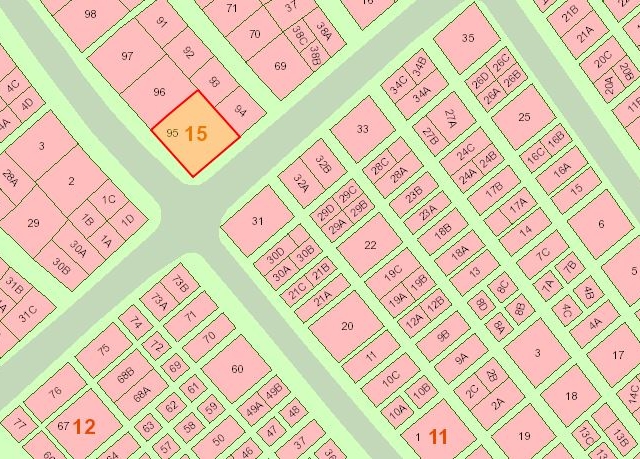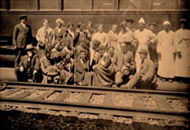John G. Barnwell (1883 – 1970 ) Rock Hill’s first City Manager was John Gibbes Barnwell, Sr. He was born September 12, 1883 in Georgetown County, SC., the son of W. H. Barnwell and Annie S. Mazyck Barnwell. In 1900, he was a student at Clemson College in the engineering department. After receiving his engineering degree, he worked for a time in the electrical department of a cotton mill in Columbia. About 1906, he became Superintendent of the water and light plants in York. While in York, he married Meta Deas Boykin about 1908. Meta was born in Kershaw County on November 2, 1883 to Samuel and Leila Ancrum Boykin. The 1910 Census shows the couple living in York with no children. They were renting a house, and John is listed as Superintendent of the city electric plant. In the Census, Meta in mistakenly called “Neta O. Barnwell.” John served with the City of York for six years.
About 1912, John was hired as Superintendent of the Public Works Commission of the City of Rock Hill. The Commission operated with some independence from the City Council, and had been created shortly before Barnwell was named as Superintendent. Under Barnwell’s management, Rock Hill’s water and electrical system was expanded significantly. It was described as one of the best utility systems in the Carolinas, with assets of $299,196 and earnings of $8,600 per year. Extensive improvements were made, and water lines were extended to new areas.
In late 1914, the City Council voted to reorganize under the Commission-Manager form of government, with an appointed City Manager

Mr. Barnwell, courtesy of the City of Rock Hill, S.C.
working under the commission formed by the Mayor and City Council. In January 1915, there was an election for a new City Council. There were eight candidates for the three seats available. Elected were James C. Hardin, Fred A. Dunlap, and W. G. Stevens. Hardin was elected Mayor by the Council. One of the first topics for the new council was the selection of the first City Manager under the new form of government. Council members had spent some time studying the operation of the manager system in other cities.
The new position attracted several candidates. J. Claude Cauthen, who had served on the previous City Council and was general manager of the Syleuca Manufacturing Company, stated that he would “be a candidate for the new office of city manager under the new form of city government.” Others mentioned for the position were John Barnwell, Webb White, and C. K. Chreitzberg. There was no mention of a formal application or interview procedure for the position, and it is unlikely that candidates from out of town were considered. By the end of January, the Council had abolished the Public Works Commission and was prepared to select a manager. On February 1, the Council met for its regular meeting, and one of the items of business was the selection of the new manager. The name of John Barnwell was the only one presented to Council, and he was selected unanimously, “the term of office being at the will of Council, at a salary of $200.00 per month.” Barnwell was certainly a qualified candidate. Since the utility system was one of the most important functions of the City, it was logical to find someone experienced in that area, a pattern which would be repeated with many of the early city managers. In a national publication, Barnwell’s previous experience as a manager and chief engineer of utilities, both public and private, for fourteen years, was emphasized.
Barnwell immediately began to make recommendations for improvements to the Council. At his first meeting, on February 8, he proposed consolidating city offices and purchasing an addressograph machine to automate the addressing of water and light bills to reduce expenses. The Council also was busy: “The question of rules and regulations governing the work of the city manager was discussed at length, but no definite action was taken.” By the end of February, Barnwell submitted specifications for changes to the offices in City Hall (then located in the block of Hampton Street between Main and Black). He also began discussing drainage problems for a stream called Saluda Branch that originated on Black Street near Central School (now the site of the Child Development Center) and flowed south through the new subdivision of Woodland Park. Street lamps were approved for Hagins and Moore Streets and Pond Street, and an ordinance was considered for restricting chickens from running at large in town. The Council placed a bond of $10,000 on the Manager position. In March, the activity increased, with council receiving twelve reports from the manager on March 1, changes to the water and light rates being considered, the chicken ordinance passed, and an ordinance proposed prohibiting skating or bicycles on the sidewalks. The plans for solution to the Saluda Creek drainage were completed, and contacts were being made with property owners to secure easements.
It appears that the new manager made an excellent start. Obviously, his previous experience in York and with the Public Works Commission prepared him well, and he was very familiar with the city, the public needs, and the people he needed to work with.
Little is known of Barnwell’s family life. In 1911, just before coming to Rock Hill, he and his wife Meta had a son, John Gibbes Barnwell, Jr. They would have two other children, Meta Boykin Barnwell, born about 1916 while John was serving as City Manager, and William Habersham Barnwell, born in 1921. Some personal information can be found in John’s draft registration form for World War I, submitted on September 12, 1918. His home address is listed as 315 Marion Street and his occupation listed as City Manager. [Information written and submitted to R&R by Paul M. Gettys – 10.7.14]
Click on #315 Marion to see where the family resided in Rock Hill and click on the More Information link in the picture column for an extensive history.
Stay Connected
Explore history, houses, and stories across S.C. Your membership provides you with updates on regional topics, information on historic research, preservation, and monthly feature articles. But remember R&R wants to hear from you and assist in preserving your own family genealogy and memorabilia.
Visit the Southern Queries – Forum to receive assistance in answering questions, discuss genealogy, and enjoy exploring preservation topics with other members. Also listed are several history and genealogical researchers for hire.
User comments welcome — post at the bottom of this page.
Please enjoy this structure and all those listed in Roots and Recall. But remember each is private property. So view them from a distance or from a public area such as the sidewalk or public road.
Do you have information to share and preserve? Family, school, church, or other older photos and stories are welcome. Send them digitally through the “Share Your Story” link, so they too might be posted on Roots and Recall.
Thanks!
User comments always welcome - please post at the bottom of this page.





Share Your Comments & Feedback: